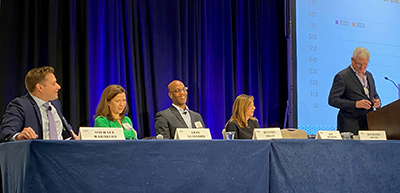
CREF22: As Issuance Rebounds, Securitization Products Adapt

(l-r: Michael Barbieri, Erin Stafford, Quentin Fogan, Jan Sternin, CMB, Richard Jones at CREF22 in San Diego on Tuesday.)
SAN DIEGO — Commercial mortgage-backed securities are evolving as issuance bounces back, analysts said here at the 2022 MBA Commercial/Multifamily Finance Convention and Expo.
Michael Barbieri, Executive Director of Capital Markets and Real Estate Finance with UBS, New York, noted total CMBS issuance ranged from $180 to $200 billion between 2005 and 2007. That level fell during the pandemic but grew to about $155 billion last year. “So, we’re not that far off from pre-crisis issuance and securitization levels,” he said.
But Barbieri also cited a “reallocation” of securitized products. “We’ve seen conduits effectively cut in half from where they were in 2017 or so,” he said. “A big part of the reason is the crisis took a lot of players out of CMBS. That spooked the market a little bit, so from a capital markets perspective we couldn’t issue as much because the demand was not going to be there.”
Erin Stafford, Managing Director and Head of North American CMBS with DBRS Morningstar, Chicago, said she sees tremendous growth in the commercial real estate-collateralized loan obligation space. “A lot of it hinges on investors and property owners wanting to put floating-rate debt on their assets so they can get it for a reasonable rate,” she said.
Stafford noted a lot of the CRE CLO market has been multifamily, but she said she expects to see more office and some hotel transactions going forward.
“The low interest rate environment has made it relatively easy for borrowers to execute that CLO execution,” said Quentin Fogan, Managing Director of CMBS Origination with Bank of America, Charlotte, N.C. “It’s also a function of the reallocation of capital deployment across the industry. Whereas before the Global Financial Crisis, banks, large conduit shops and money center institutions drove a lot of new issue, that has shifted dramatically. That has led to an evolution of the non-bank lending universe. That execution, the type of floating-rate structures that can be achieved there, impacts the conduit number. No question about it.”
Jan Sternin, CMB, Senior Vice President and Managing Director with Berkadia, New York, said a few years ago, manyf people in commercial real estate were concerned about the looming wall of maturities. “We all thought we were all going to die,” she said. “And you know what, we did just fine and here we all are. We did the same thing when COVID started–we thought every loan was going to go bad, delinquencies would go through the ceiling and we would all die. And look, we’re still here! We’re not dead yet. And things are coming back.”
